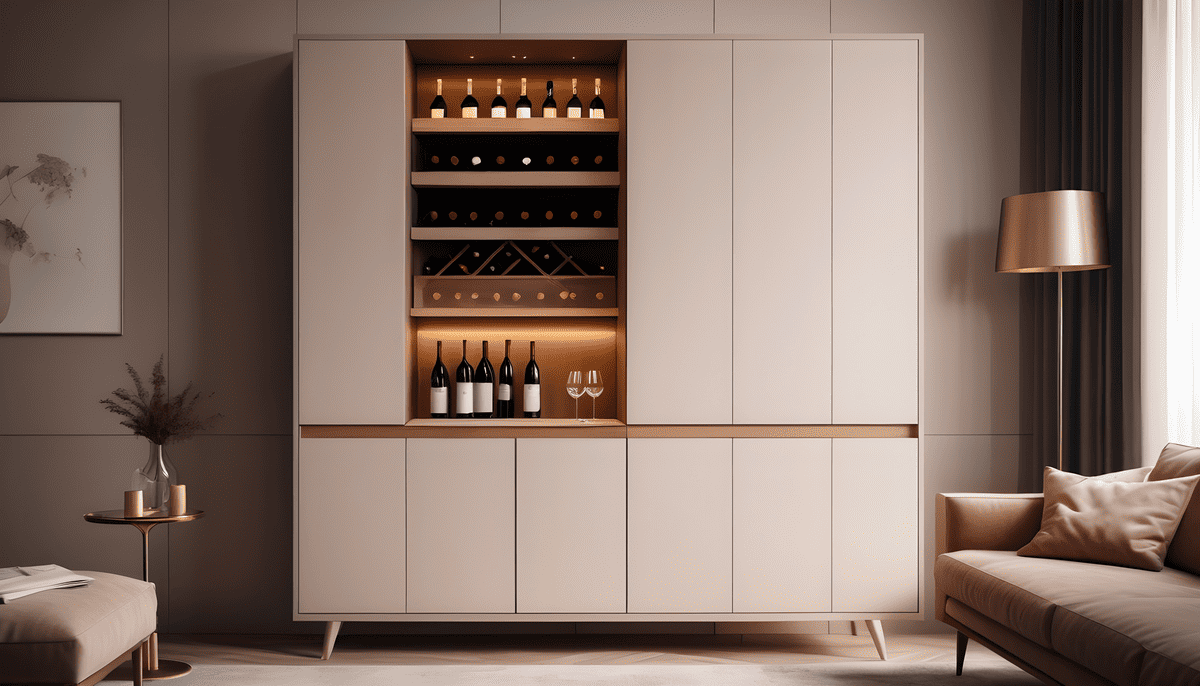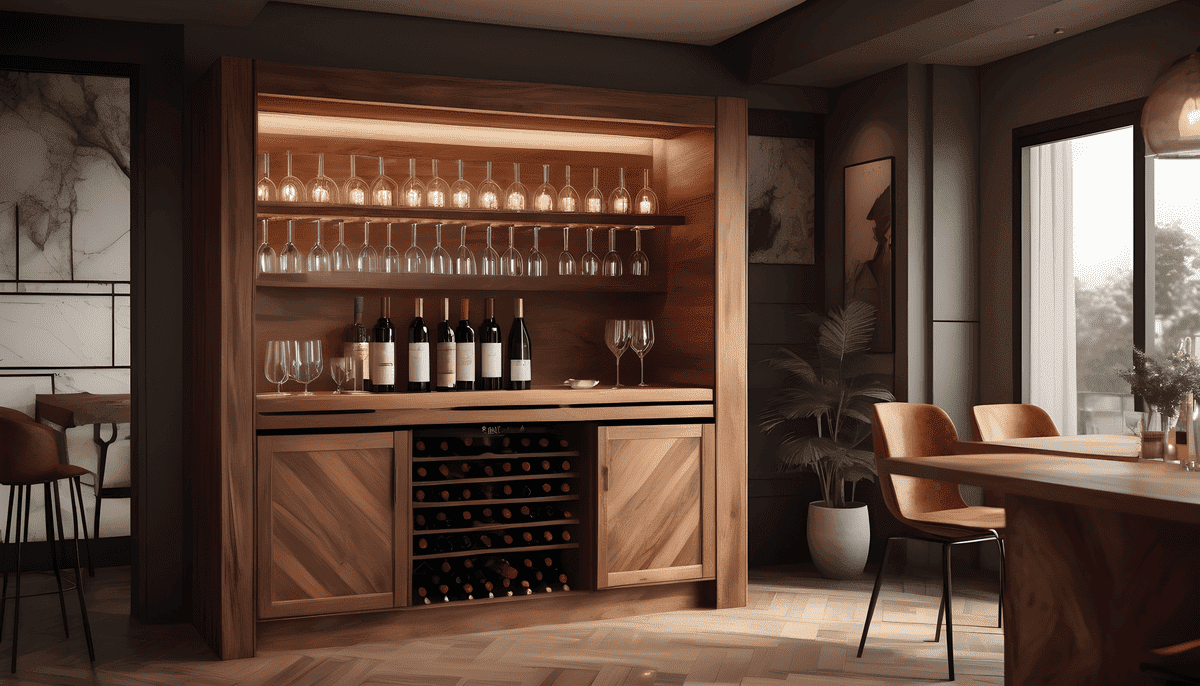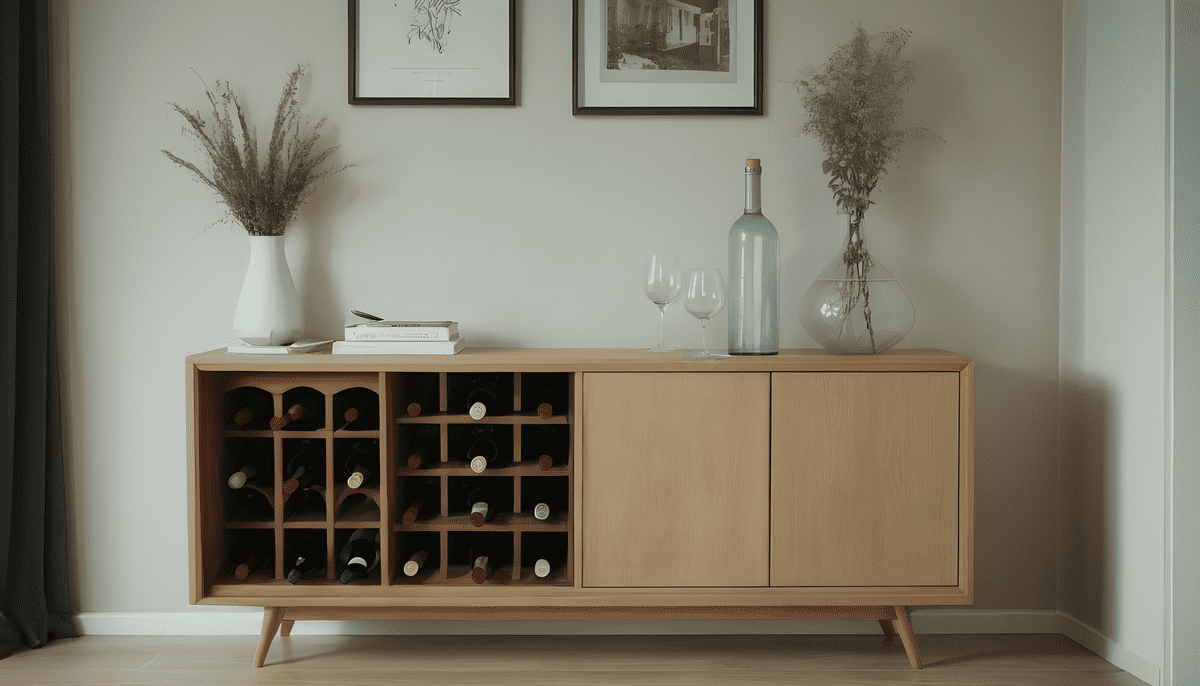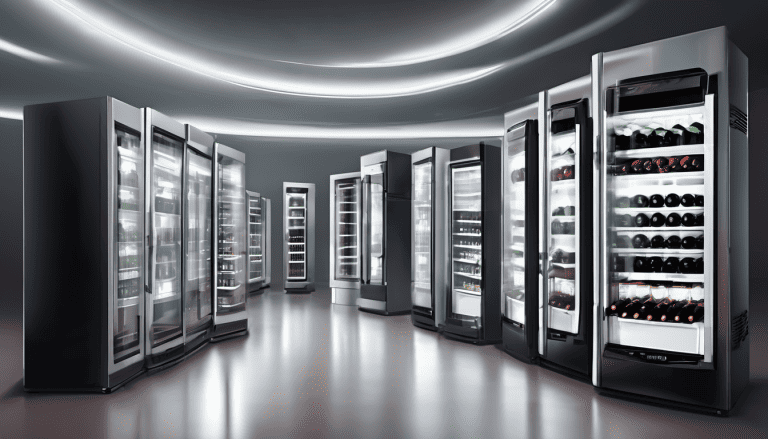Selecting a suitable Wine Storage Solution can make all the difference – find out how a Wine Cabinet could be the perfect solution for you.
This guide shall explain what a Wine Cabinet is, show the most common variations, their “pros and cons”, and other essential factors to consider when evaluating a purchase.
Welcome to Didi Somm, and let’s dive in!
Important Notice: The information in this article is for general and public information purposes only. It solely reflects Didi Somm’s or his Staff’s opinion, and no responsibility can be assumed for errors or omissions in the service’s contents. For details, please check the Disclaimer at the bottom of the homepage.
What Is a Wine Cabinet?
A wine cabinet is more than just a piece of furniture; it’s a functional and stylish solution for storing and showcasing your wine collection.
Wine Cabinets are not only sold “ready-made” but often “made to order” according to the client’s requests and needs.
Climate-controlled wine cabinets maintain optimal conditions for wine storage, including temperature, humidity, and protection from light and vibration.

The Variety of Wine Cabinets includes…
1. The “Refrigerated” Wine Cabinet
A refrigerated wine cabinet is specifically designed for long-term storage and aging. It is an elegant piece of furniture that serves a long-term purpose. Its main features are the following:
Offer multiple environmental conditions (humidity, temperature, light) for optimal long-term storage and aging.
Unlike wine refrigerators and coolers, they are fully repairable and can have their cooling units replaced and maintained as time passes.
Can have their wine racks adjusted, swapped, or removed to account for wine collections that change size, configuration, or bottle size
Allow wines to age gracefully and develop their qualities. They maintain a consistent temperature range, usually around 55-59°F or 12–14°C. They are a kind of “mini” Wine Cellar.
With additional storage for stemware and accessories, these cabinets are ideal for serious wine collectors looking to preserve their investments for years.
This type is highly recommended if you:
Don’t have a wine cellar and are counting on your cabinet to control the temperature.
Have a wine cellar but need a smaller collection of wine stored at a temperature different from your main cellar, e.g., for serving wine in your living/dining room area.
2. The “Serving” Wine Cabinet
Serving wine cabinets are refrigerated to keep your wines at the perfect serving temperature.
Convenient for entertaining guests or enjoying a glass after work, these cabinets blend functionality with aesthetics, enhancing your wine experience and interior decor.

3. The “Multifunctional” Wine Cabinet
Multifunctional wine cabinets offer versatility, serving as a bar or countertop while providing storage for glassware and accessories (picture below).
These cabinets maximize functionality for small spaces or multifunctional rooms without compromising style or storage capacity.

4. The “Non-Refrigerated” Wine Cabinet
Non-refrigerated wine cabinets primarily serve as display pieces, showcasing your wine collection while adding elegance to your home decor (2 pictures below).
Without a cooling system, these cabinets are not suitable for long-term storage but are ideal for displaying prized bottles and creating a sophisticated ambiance in your living space.


Factors to Consider When Choosing a Wine Cabinet
1. What Size is Best for You?
Bottle capacity is usually the first and most important factor when shopping for wine storage cabinets. It affects how the furniture fits in your home, and it is usually prominently advertised in the unit’s name or title, so you can hardly miss it.
However, you may not be able to fit 50 wine bottles in a 50-bottle wine cabinet since multiple variables can change the total bottle capacity, such as the types and shapes of bottles, shelving materials, and how the bottles are configured within the cabinet.
The standard wine storage capacities are based on the high-shouldered Cabernet Sauvignon bottle. If your collection contains wider-based bottles like Pinot Noir, Burgundy, Alsace, Champagne, and Chardonnay, the officially indicated capacity does not apply to you. Still, you must purchase a wine storage cabinet with a larger stated capacity than the number of bottles you want.
Another issue is that wooden shelves take up more space than shelves of scalloped wire. While wooden shelves will work perfectly for storing standard, Cabernet-style bottles, scalloped-wire shelves with a slight dip in them offer more vertical room for atypical bottles.
Lastly, be aware of how the manufacturer of the wine cabinet recommends the bottles being stored. If the unit wasn’t built to accommodate wines stored in only one direction, and that’s your preferred storage configuration, the unit won’t handle the officially indicated bottle capacity.
2. What Material Should You Choose?
Wine cabinets come in various materials, including wood, metal, or glass. Select a material that complements your home decor and enhances the aesthetic appeal of your living space.
Consider factors such as durability, maintenance requirements, and aesthetic preferences when choosing the material for your wine cabinet (picture below), a modern style metal/glass combination.


3. How Many Temperature Zones Do You Need?
Dual-Zone: Red and white wines have different optimal storage temperatures, so having a dual-zone wine storage cabinet is ideal: one for red and one for white.
The drawback is that temperatures in the two zones should not constantly change up or down to serving temperature since this would compromise the quality of the wine.
Multi-functional Zones: You’ll need a multi-functional cabinet if you’d like the wine cabinet to bring wines up or down to serving temperature (which is different for whites and reds, etc.).
Such a wine cabinet has more temperature zones separate from dual-zone storage. Those additional temperature zones can be brought up or down depending on the wine you’ll place in it and prepare for serving.
4. Protect Your Wines from Light Exposure (UV)
Choose a wine cabinet with adequate protection against light exposure to prevent premature aging and deterioration of your wines’ taste and aroma.
Look for wine cabinets with UV-resistant glass doors or solid doors that block out light to ensure your wines remain in optimal condition while in storage.
5. Organization in the wine cabinet
Arrange your wine bottles systematically by type (red, white, sparkling) or grape variety for easy tracking and access.
Utilize a grid system or labeling method to maintain organization and maximize storage space within your wine cabinet.
Consider factors such as bottle size, shape, and accessibility when organizing your wine collection to ensure efficient use of space and easy retrieval of bottles when needed.
Pro Tip: Suitable wine racking is most important for efficiently organizing your wine cabinet. For further information and racking ideas, please check Wine Racks of America, a top company in this field.
Pros and Cons of Wine Cabinets
FAQ
1. How do I choose the right size Wine Cabinet for my collection?
To select a cabinet that accommodates your needs, consider the size of your wine collection and potential future growth. Factor in available space in your home, and consider investing in a cabinet with expandable storage options if your collection is likely to grow over time.
Measure the dimensions of the space where you plan to place the cabinet to ensure it fits comfortably and allows for proper airflow and access to the bottles.
2. Are Wine Cabinets suitable for long-term storage?
Wine cabinets with climate control features are ideal for long-term storage, providing the optimal conditions for preserving your wines’ quality and flavor over extended periods.
Maintaining stable temperature and humidity levels, these cabinets help prevent oxidation, microbial growth, and other factors that can compromise wine quality and taste over time.
Regular maintenance and monitoring are essential for ensuring that your cabinet continues to operate effectively and that your wines remain in optimal condition for years.
Models without climate control offer a functional and stylish solution for short-term storage and showcasing your wine collection.
3. What is the difference between a Wine Cabinet and a Wine Closet?
While wine cabinets and closets are designed to store and preserve wine collections, they differ in size, capacity, design, and functionality.
Wine cabinets are smaller, standalone pieces of furniture suitable for displaying a limited number of bottles. In contrast, wine closets are larger, dedicated spaces designed to accommodate more extensive collections and provide optimal storage conditions for aging wine.
4. How many bottles of wine can be stored in a Wine Cabinet?
The number of wine bottles in a cabinet can vary widely depending on factors such as size, design, shelving configuration, and the types of wine bottles being stored.
It’s essential to consider these factors when choosing a wine cabinet to ensure it meets your storage needs.
5. Is there a Wine Cabinet with Temperature- and Humidity Control?
Yes, there are wine cabinets in the market equipped with temperature and humidity control features. These cabinets are designed to provide optimal wine storage conditions, helping preserve the wine’s flavor, aroma, and quality over time.
When choosing a cabinet with temperature and humidity control, it’s essential to consider factors such as capacity, design, energy efficiency, and ease of maintenance.
Investing in a high-quality wine cabinet with these features can help safeguard your wine collection and ensure it ages gracefully over time.
6. Does a Wine Cabinet need maintenance?
Like any other appliance or furniture, a wine cabinet requires maintenance to ensure optimal performance and longevity.
Here are some maintenance tasks typically associated with wine cabinets:
Regular cleaning of the interior and exterior
Regular checks and replacement of air filters
Cleaning of the ventilation system
Inspection of seals and gaskets
Monitoring temperature and humidity
- Periodical inspection for leaks and professional servicing.
By performing regular maintenance tasks and addressing any issues promptly, you can help prolong the lifespan of your wine cabinet and ensure that it provides reliable storage for your wine collection.
7. How much does a Wine Cabinet cost?
The cost of a wine cabinet can vary significantly depending on several factors, such as the brand, size, material, design, and features.
While basic designs start from around $100-$500, high-end, custom-built models with temperature control, humidity control, UV protection, and other advanced features cost thousands or even tens of thousands of dollars, depending on the complexity of the design and materials used.
Consider your needs, budget, and required features when shopping for a wine cabinet.
Factors like warranty, customer support, and brand reputation should also be considered when purchasing.
8. Should I buy a Wine Cabinet or a Wine Cooler/Refrigerator?
We recommend opting for a wine cooler or wine refrigerator if:
Your wine collection is smaller than 50 bottles
You are looking for a cost-effective solution.
You don’t intend to age your wines longer than 6 to 12 months
(Remark: “High-end” Wine Refrigerators offer both aging and serving capabilities)
9. What is the ideal temperature range for the aging of wine?
The ideal temperature range for long-term storage and aging is 55°F – 58°F – both for red and white wine. Wine will age more rapidly at higher temperatures.
Conclusion
As mentioned in the introduction, selecting the best suitable wine storage solution depends on your personal preferences and comes down to the following 3 questions:
- Your Wine Collection Size & Storage Horizon? Answer: 50 bottles or more, serving- & aging requirements
- Your Budget? (Remark: Climate-controlled Wine Cabinets are more expensive than Coolers/Refrigerators)
- Aesthetics & Customization are essential for you? – If yes, then a Wine Cabinet perfect for you
In the “buying process” of your wine cabinet, please consider the “10 Essential Points” below:
Bottle Capacity: Choose a cabinet that accommodates your current collection and allows room for future growth.
Bottle Size and Configuration: Consider the types and shapes of bottles in your collection to ensure they fit comfortably within the cabinet.
Material: Select a material that complements your home decor, considering factors such as durability and maintenance requirements.
Temperature Zones: Determine the number of temperature zones you need based on the types of wine you plan to store and serve.
Light Exposure: To protect your wines from light exposure, opt for a cabinet with UV-resistant glass doors or solid doors.
Organization: Arrange your wine bottles systematically by type or grape variety for easy access and efficient use of space.
Pros and Cons: Consider the benefits and limitations of wine cabinets, including preservation, customization, aesthetics, functionality, limited capacity, and cost.
Maintenance: Understand the maintenance requirements of your chosen cabinet, including cleaning, air filter replacement, and temperature monitoring.
Budget: Evaluate your budget and consider the cost of the cabinet compared to its features and benefits.
Long-Term vs. Short-Term Storage: Determine whether you need a cabinet for long-term aging or short-term serving purposes, and choose accordingly.
By carefully weighing these factors, you can select a wine cabinet that meets your storage needs, enhances your wine experience, and adds elegance to your home.
Cheers to finding the perfect wine cabinet for you!
For your reference – the latest articles by Didi Somm include:
The Art of Wine Storage: 30 Best Tips to Preserve Your Wines
- From Wood to Stone – The Best 5 Wine Cabinet Materials for You
Important Notice: The information in this article is for general and public information purposes only. It solely reflects Didi Somm’s or his Staff’s opinion, and no responsibility can be assumed for errors or omissions in the Service’s contents —for details, please check the Disclaimer at the bottom of the homepage.




